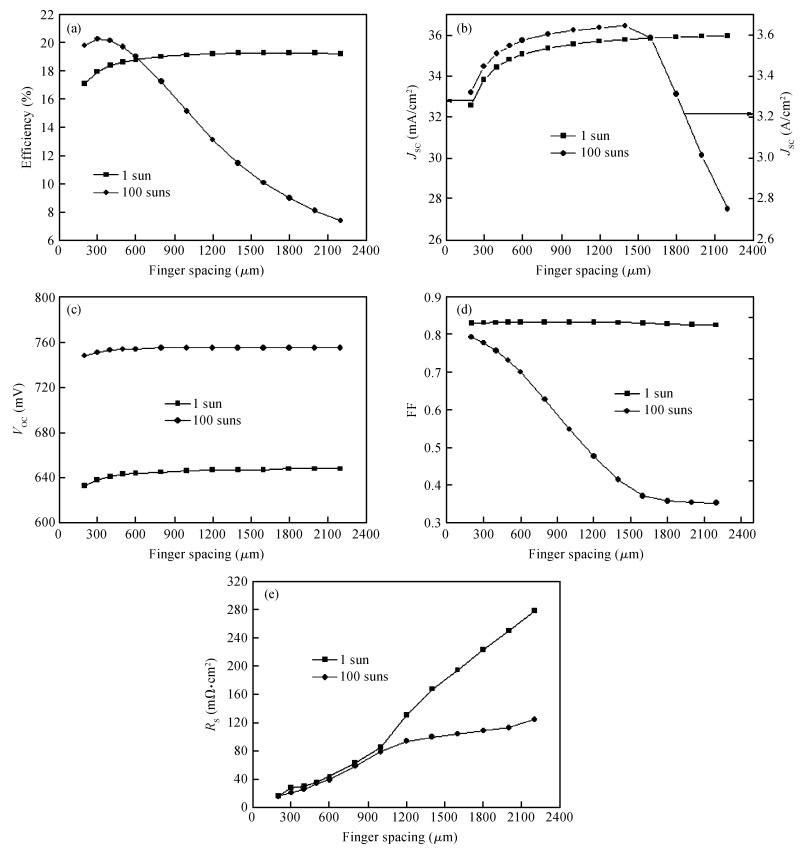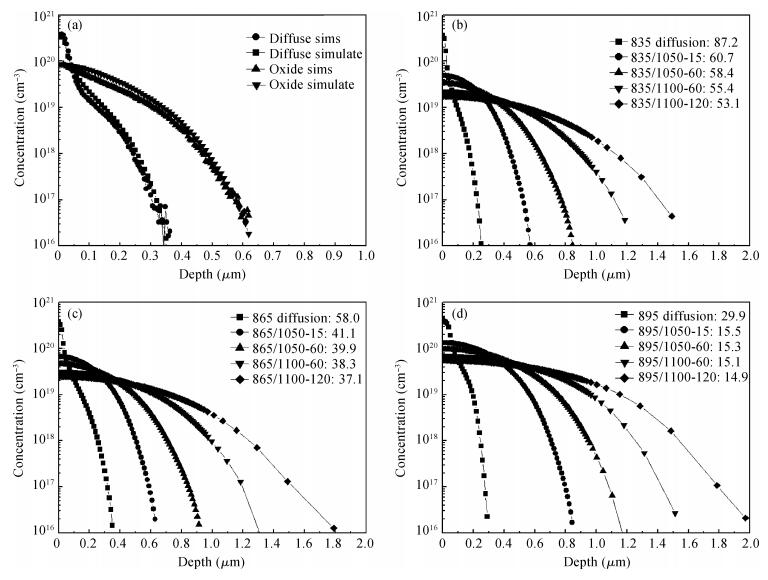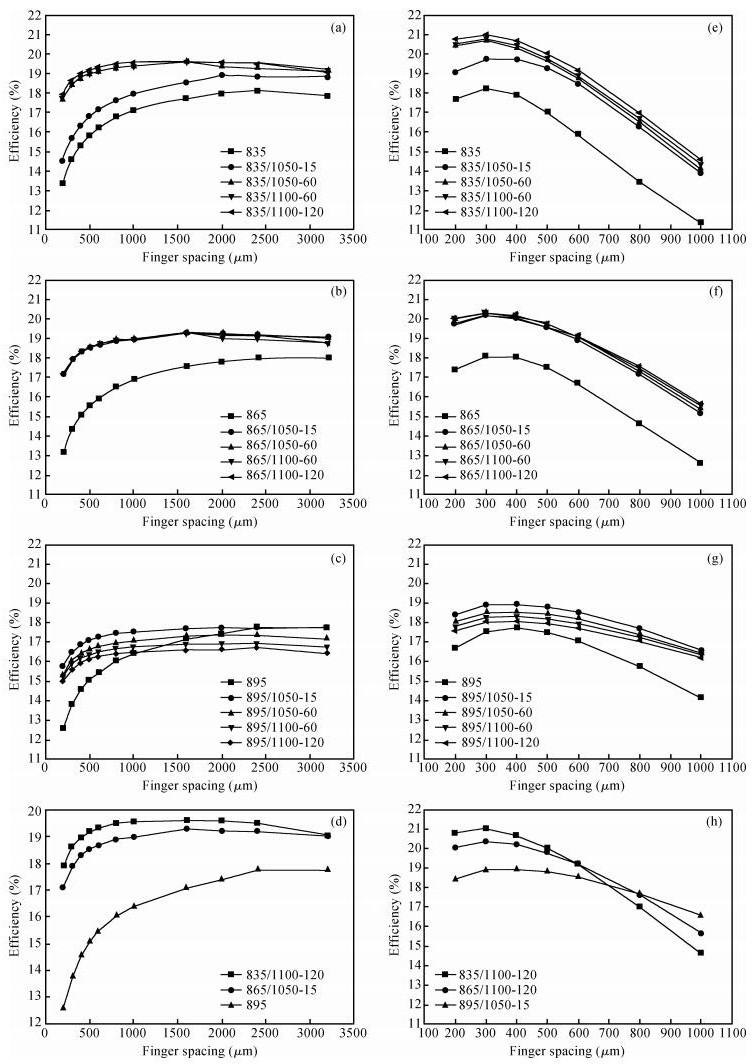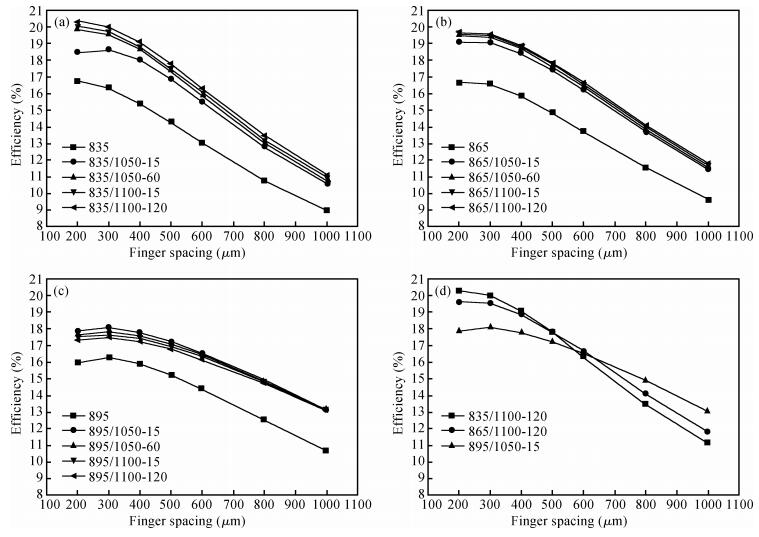| Citation: |
Yupeng Xing, Peide Han, Yujie Fan, Shuai Wang, Peng Liang, Zhou Ye, Shaoxu Hu, Xinyi Li, Shishu Lou, Chunhua Zhao, Yanhong Mi. Optimization of the emitter region and the metal grid of a concentrator silicon solar cell[J]. Journal of Semiconductors, 2013, 34(5): 054005. doi: 10.1088/1674-4926/34/5/054005
****
Y P Xing, P D Han, Y J Fan, S Wang, P Liang, Z Ye, S X Hu, X Y Li, S S Lou, C H Zhao, Y H Mi. Optimization of the emitter region and the metal grid of a concentrator silicon solar cell[J]. J. Semicond., 2013, 34(5): 054005. doi: 10.1088/1674-4926/34/5/054005.
|
Optimization of the emitter region and the metal grid of a concentrator silicon solar cell
DOI: 10.1088/1674-4926/34/5/054005
More Information
-
Abstract
The optimizations of the emitter region and the metal grid of a concentrator silicon solar cell are illustrated. The optimizations are done under 1 sun, 100 suns and 200 suns using the 2D numerical simulation tool TCAD software. The optimum finger spacing and its range decrease with the increase in sheet resistance and concentration ratio. The processes of the diffusion and oxidization in the manufacture flow of the silicon solar cells were simulated to get a series of typical emitter dopant profiles to optimize. The efficiency of the solar cell under 100 suns and 200 suns increased with the decrease in diffusion temperature and the increase in oxidation temperature and time when the diffusion temperature is lower than or equal to 865℃. The effect of sheet resistance of the emitter on series resistance and the conversion efficiency of the solar cell under concentration was discussed.-
Keywords:
- silicon solar cell,
- numerical simulation,
- concentrator
-
References
[1] Slade A G V. 27. 6% efficient silicon concentrator cell for mass production. 15th International Photovoltaic Science and Engineering Conference, Shanghai, 2005: 701[2] Castro M, Antón I, Sala G. Pilot production of concentrator silicon solar cells:approaching industrialization. Solar Energy Materials and Solar Cells, 2008, 92(12):1697 doi: 10.1016/j.solmat.2008.08.001[3] Zhao J, Wang A, Green M A. Emitter design for high-efficiency silicon solar cells. Part Ⅰ: terrestrial cells. Progress in Photovoltaics: Research and Applications, 1993, 1(3): 193[4] Cuevas A, Russell D A. Co-optimisation of the emitter region and the metal grid of silicon solar cells. Progress in Photovoltaics:Research and Applications, 2000, 8(6):603 doi: 10.1002/(ISSN)1099-159X[5] Morvillo P, Bobeico E, Formisano F, et al. Influence of metal grid patterns on the performance of silicon solar cells at different illumination levels. Mater Sci Eng B, 2009, 159/160(0):318[6] Morales-Acevedo A. Optimum concentration factor for silicon solar cells. Solar Cells, 1985, 14(1):43 doi: 10.1016/0379-6787(85)90005-5[7] Parvate V G, Sundersingh V P. Analysis and optimization of a concentrator solar cell. Microelectron J, 1990, 21(1):41 doi: 10.1016/0026-2692(90)90007-P[8] Green M A. Solar cells, operating principles, technology and system applications. Englewood Cliffs:Prentice Hall, 1982[9] Liu Wen, Li Yueqiang, Chen Jianjun, et al. Optimization of grid design for solar cells. Journal of Semiconductors, 2010, 31(1):014006 doi: 10.1088/1674-4926/31/1/014006[10] Aberle A G, Wenham S R, Green M A, et al. Decreased emitter sheet resistivity loss in high-efficiency silicon solar cells. Progress in Photovoltaics:Research and Applications, 1994, 2(1):3 doi: 10.1002/(ISSN)1099-159X[11] Altermatt P P, Heiser G, Aberle A G, et al. Spatially resolved analysis and minimization of resistive losses in high-efficiency Si solar cells. Progress in Photovoltaics:Research and Applications, 1996, 4(6):399 doi: 10.1002/(ISSN)1099-159X[12] Morales-Acevedo A. Lateral current effects on the voltage distribution in the emitter of solar cells under concentrated sunlight. Solar Energy, 2009, 83(4):456 doi: 10.1016/j.solener.2008.09.005[13] PC1D User's Manual. www. pv. unsw. edu. au[14] Armstrong G A, Maiti C K. TCAD for Si, SiGe and GaAs integrated circuits. London: The Institution of Engineering and Technology, 2007[15] Michael S, Bates A. The design and optimization of advanced multijunction solar cells using the Silvaco ATLAS software package. Solar Energy Materials and Solar Cells, 2005, 87(1-4):785 doi: 10.1016/j.solmat.2004.07.051[16] Daliento S, Lancellotti L. 3D analysis of the performances degradation caused by Rs in concentrator solar cells. Solar Energy, 2010, 84(1):44 doi: 10.1016/j.solener.2009.08.014[17] Meier D L, Schroder D K. Contact resistance:Its measurement and relative importance to power loss in a solar cell. IEEE Trans Electron Devices, 1984, 31(5):647 doi: 10.1109/T-ED.1984.21584[18] Pysch D, Mette A, Glunz S W. A review and comparison of different methods to determine the Rs of solar cells. Solar Energy Materials and Solar Cells, 2007, 91(18):1698 doi: 10.1016/j.solmat.2007.05.026[19] Uematsu M. Simulation of boron, phosphorus, and arsenic diffusion in silicon based on an integrated diffusion model, and the anomalous phosphorus diffusion mechanism. J Appl Phys, 1997, 82(5):2228 doi: 10.1063/1.366030 -
Proportional views





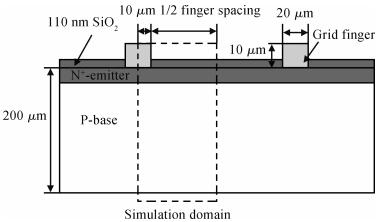
 DownLoad:
DownLoad:
